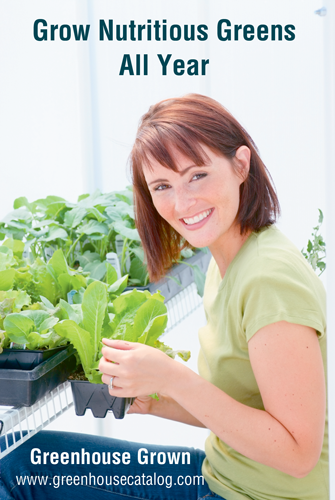Winter Greenhouse Growing: Fast, Nutritious Leafy Greens in Cool Weather

Are you wondering what you can grow in your winter greenhouse? While winter may be an inconvenience to fresh-food aficionados, many gardeners don’t miss a beat…or maybe I should say a salad. If you are fortunate enough to have a greenhouse or cold frame, you don’t have to wait for warmer weather to get in on the action. With minimal effort you can enjoy homegrown salads all winter long. You won’t worry about freshness and quality. Better yet, growing salad greens in your greenhouse is rewarding and you don’t need to brave the elements to harvest your dinner. Salad greens are among the easiest crops to grow in a winter greenhouse. The enjoyment you gain from growing the greens matches the dollars you save, and it’s nice to know what’s in your food!
Growing lettuce is quick, easy and rewarding!
It’s probably not surprising that cool weather crops are often the easiest to grow in a greenhouse. Lettuce is a fast growing vegetable that will germinate and mature quickly. In only a few weeks your seeds will sprout and you will be harvesting your own salad. Leaf lettuce varieties are especially quick because it’s easy to harvest a few leaves at a time. When you plant several types at once or a mix like mesclun you’ll get maximum flavor and texture. Unlike store-bought varieties, the lettuce you grow will have flavor to spare and will contain far more nutrients than lettuce sitting on a grocer’s shelf for days.
Choosing the right greenhouse for growing lettuce: Benefits and considerations
Several cold tolerant lettuce varieties can be grown without a greenhouse with the proper planning and effort. A greenhouse, however, will allow you the most flexibility and ease. You can grow a wider variety of crops and you can plant anytime without planning around your frost dates plus you won’t have the hassles of constant maintenance and attention needed with row covers. There are many types of greenhouses available today. The quality, function and construction differ greatly. Before you start, it is helpful to determine if your greenhouse will work for lettuce in your area. The likely answer is yes, but that will depend on your climate and your expectations. Many products called greenhouses are really large cold frames designed to keep the frost at bay. The true definition of a greenhouse is a heated structure, although only a few of the greenhouses sold today are designed for heat.
With a cold frame, you are able to start most plants a few weeks earlier than planting outside and grow a few weeks longer in the fall. In most cases, the area under cover may be a degree or two warmer than the outside temperature. Most cold frames have only single wall construction making them impractical to heat, or they are too small to effectively and safely control the temperature. If you live in a temperate climate, a cold frame may be all you need to grow lettuce. If your winter nights get much below freezing, you will want to use a structure where you can add a little heat if you want to actively grow.
If your greenhouse covering is double walled and larger than 60 square feet, you likely can add heat. You will decide how warm you want to keep your greenhouse, but fall crops like lettuce require only minimal heat to thrive. In fact, lettuce will do much better in a cool environment that a warm one. A cool greenhouse would be one with night time temperatures of 40 degrees. Lettuce can survive freezing conditions if it’s near maturity, however, it will not continue to grow until the temperatures warm.
Tips for growing winter lettuce in a greenhouse

To start your lettuce, you will want to germinate your seeds at a minimum of 45 degrees. Slightly warmer temperature will speed the process slightly and cooler temperatures will slow the process. If you are starting the seeds between November and January when the days are short, a grow light will speed the germination to transplant time considerably. There are many light choices that will work well with some being as simple as a clip light that can be used in a greenhouse or indoors. Depending on how much room you have and where you want to start your seeds, you can plant directly in your container or start seeds in a flat and transplant them when they are a few inches tall. If you plan to start your seeds in a cool greenhouse, for faster results, you may want to start the seeds in a shallow flat and place them on a seedling heat mat. The mat will supply heat to the roots so you won't have to heat the entire greenhouse to the warmer temperature required for germination. Once the seedlings are a few inches tall, transplant them into your containers and leave plenty of room for growth.
After the seedlings are established, keep them moist and fertilize them well. You can start to harvest the lettuce at any point. The young lettuce is the most tender and flavorful, but your yields will be small. Ideally you will want to harvest the outer leaves (leaf lettuce) and leave the centers to mature, however, you can cut the entire plant above the roots and it will continue to grow for several months before it starts to turn bitter. Planting a fresh crop every two to three weeks will ensure a steady supply. The seedlings will grow quickly so it’s easy to experiment with different varietals and different amounts to discover what and how much you like. Your lettuce should thrive until your greenhouse starts getting quite warm in the late spring or summer.
Additional tools for successful winter greenhouse growing
If you have not grown vegetables in a winter greenhouse before, you will be hooked when you experience the ease and rewards yourself. You will love spending time in your winter oasis and soon you will want to try other cool crops like spinach, kale, arugula, leeks, and carrots. These vegetables are easy to grow in a greenhouse and make a wonderful addition to any salad. There are many products too that can make your job even easier. Seedlings benefit most from extra heat to the roots and extra light in winter. Seedling heat mats will help you germinate the seedlings quickly in flats with minimal heating costs. Soil cables work well when you want to plant directly in the ground in a cold frame. Grow lights will accelerate winter growth. With products ranging from a single spot light for one plant to a large fixture emitting more than 40,000 lumens, there are choices in every price range. New self watering containers and products like the Earth Box will help maintain a consistent moisture and nutrient level and create the optimal soil conditions. For an automated approach, it's hard to beat a hydroponic system. Regardless of the methods you choose, you will love using your greenhouse in the winter and spending time in your greenhouse is a good way to chase away the winter blues. You can eat the greens and spend the dollars you save on a few beautiful tropical plants this summer. Don't worry; they'll do just fine in your greenhouse beside the lettuce next winter.Michelle Moore is the general manager for The Greenhouse Catalog. She is an Oregon State University Master Gardener and has nearly 20 years experience working with greenhouses. She lives in Oregon with her husband where they are gardening outside of a greenhouse for the first time. You can contact Michelle at mmoore@adapt8.us






